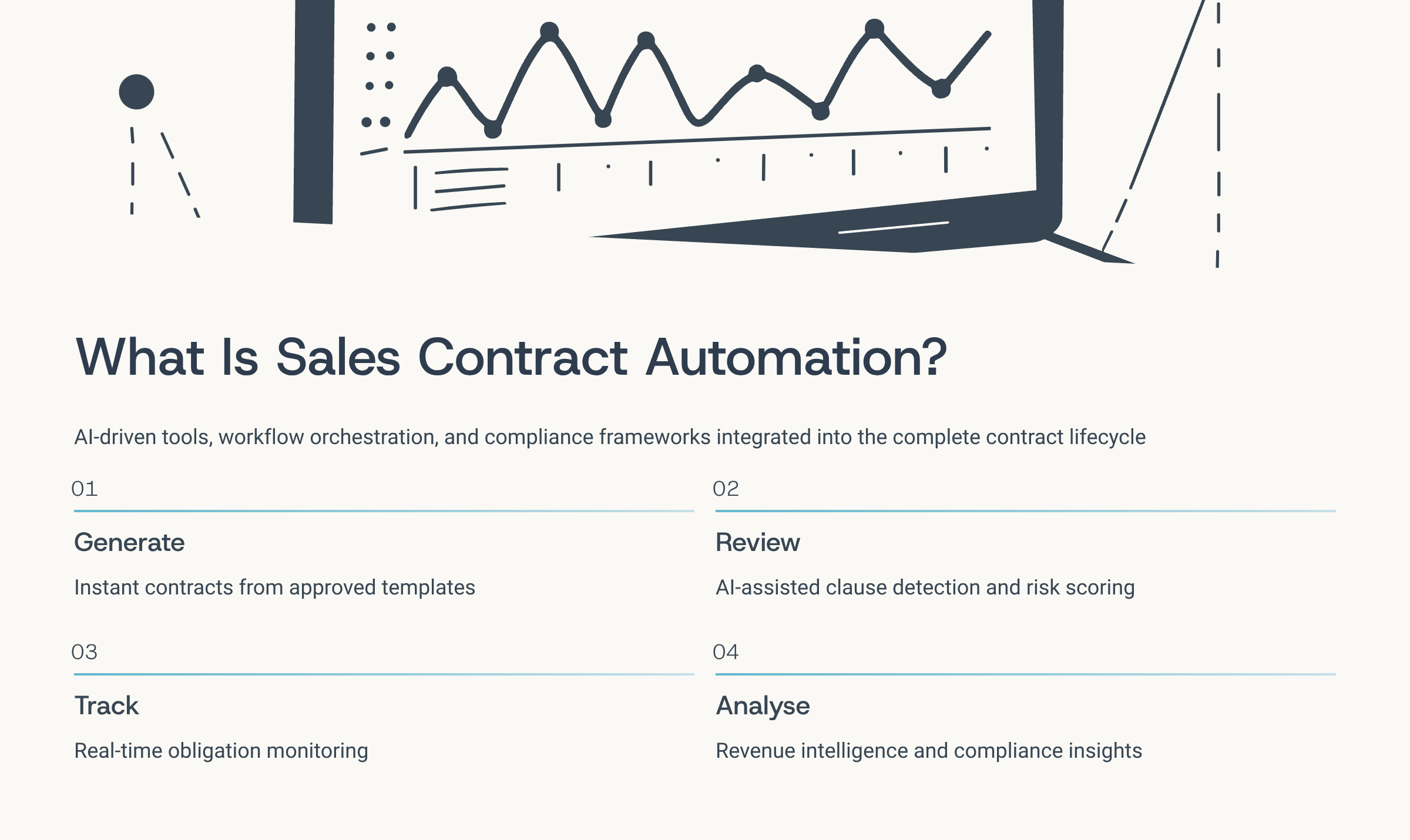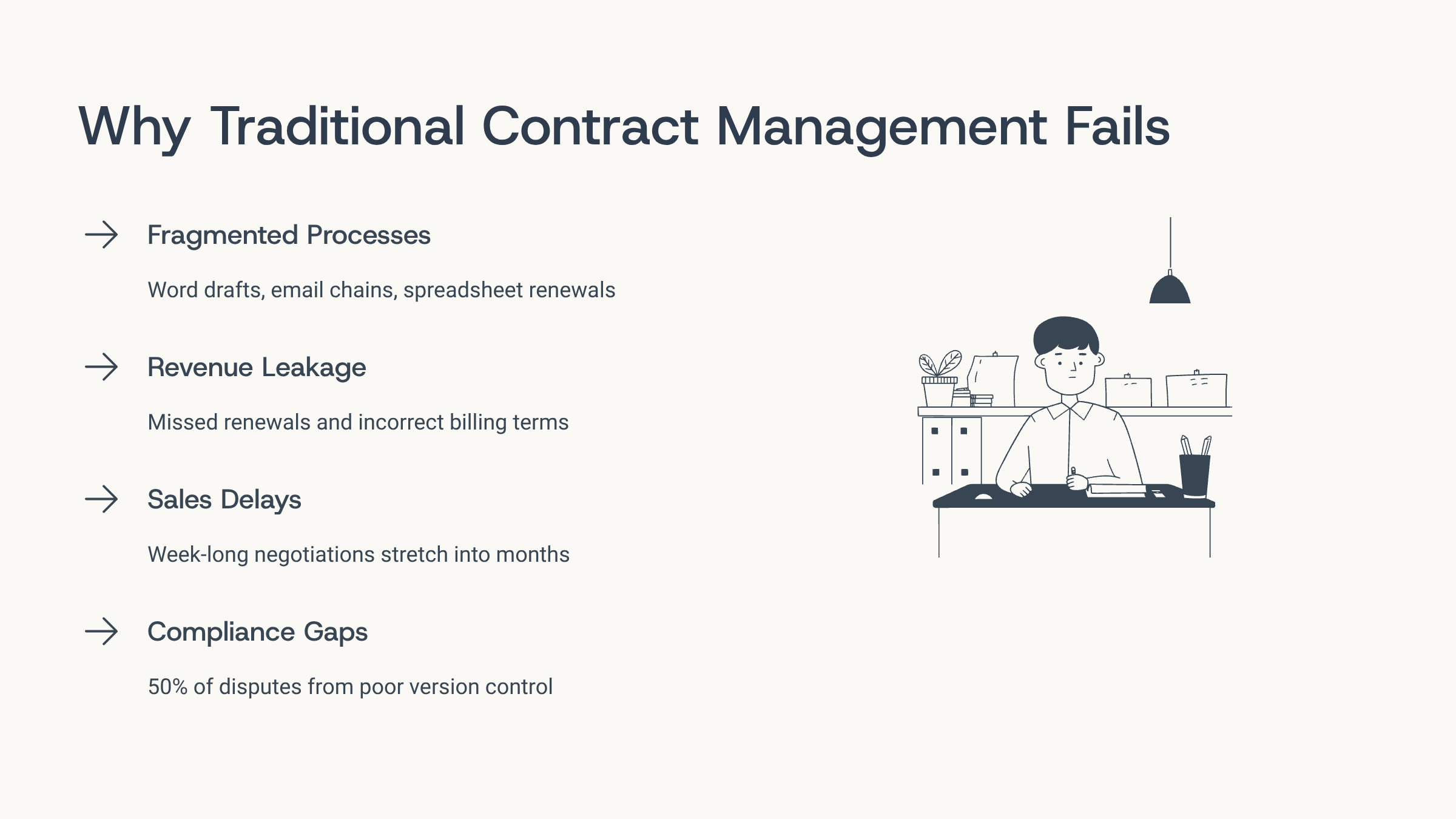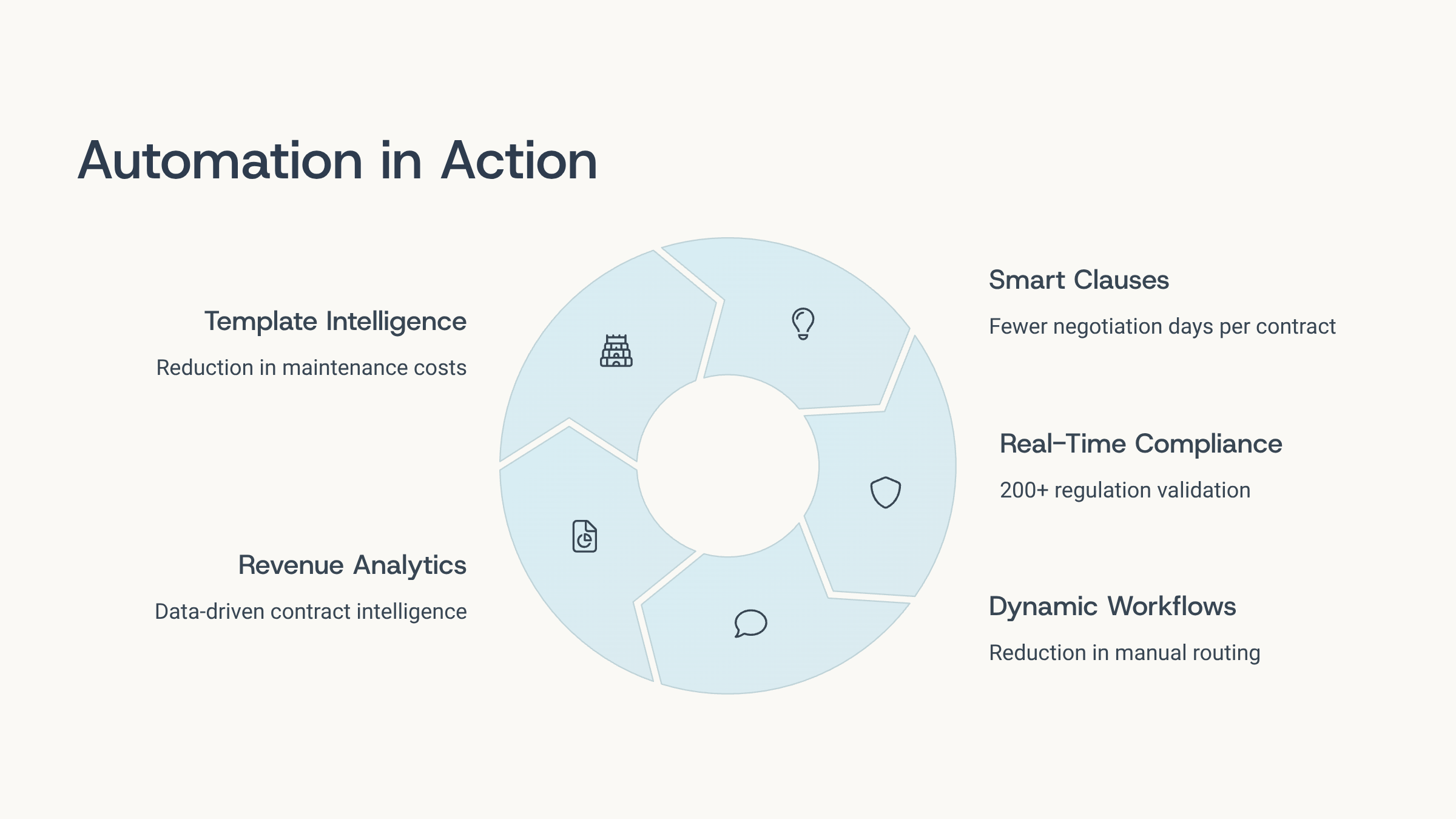Sales Contract Automation: Turn Your Legal Bottleneck Into a Revenue Accelerator
Article written by
Kate Williams

INSIDE THE ARTICLE
SHARE THIS ARTICLE
Summary
Legal delays are killing your deals. This blog shows how sales contract automation replaces bottlenecks with velocity—cutting cycle times from weeks to days, reducing legal workload, and driving faster revenue. If your deals stall after verbal agreement, it's time to fix your contract workflow and stop losing to faster competitors.
Have you noticed? Legal teams often get stuck in endless back-and-forths with contracts, sales leaders watch deals go cold, procurement is busy chasing missed details, and finance is left worrying about lost money.
Funny thing is, contracts are supposed to protect a business—not slow it down. But when they’re managed the old-school way, they turn into roadblocks instead of helping growth.
That’s where sales contract automation steps in. Instead of juggling Word files and email threads, everything flows through one smooth system. Deals move faster, compliance gets easier, and revenue becomes clearer. In this blog, we’ll look at how contracts stopped being boring paperwork and started becoming real growth drivers.
What Is Sales Contract Automation?
Sales contract automation is all about taking the messy, manual parts of contract work and putting them on autopilot with smart technology. Instead of drowning in Word docs, endless email threads, or scattered Slack messages, everything happens in one organized system from start to finish.
Here’s how it plays out in real life:
- Sales teams can spin up contracts in minutes using pre-approved templates.
- Legal doesn’t have to comb through every clause manually—AI highlights risks and flags issues.
- Procurement can finally track obligations without sticky notes or spreadsheets.
- Finance gets a clear view of revenue terms, discounts, and renewals, instead of being left in the dark.
- Compliance teams stay ahead by automatically checking contracts against changing rules and regulations.
And for global companies, it goes a step further—handling multiple languages and regional laws all at once, so you don’t have to.

Why Traditional Contract Management Fails SaaS Enterprises
Even though contracts are the backbone of enterprises, most enterprises are still managing them with outdated and fragmented workflows that simply can’t keep up with the pace of modern SaaS.
Here’s what that usually looks like:
- Drafting happens in Word docs stored on desktops.
- Approvals vanish into endless email threads.
- Negotiations are buried in redlined files across Teams or Slack.
- Renewal dates hide in spreadsheets no one checks on time.
At scale, this patchwork approach creates issues that directly undercut growth. Here are a few of the reasons why traditional contract management fails enterprises:
Revenue Leakage
When renewals slip through the cracks, billing terms are applied inconsistently, or unfavorable auto-renewals go unnoticed, businesses lose money they can’t afford to leave on the table.
Sales Delays
Every extra day a contract spends in legal review is another day revenue is stalled. Deals that should close in days stretch into weeks, slowing momentum and leaving room for competitors to step in.
Compliance & Risk Exposure
Manual oversight often leads to inconsistent terms, outdated clauses, or missed obligations. In a global SaaS landscape, even small lapses create outsized legal and reputational risks.
Operational Drag Across Teams
Sales pushes for speed, legal demands control, finance needs accuracy, and procurement prioritizes compliance. Without automation, these goals collide, creating bottlenecks instead of alignment.
For scaling enterprises, these are direct threats to ARR, renewal rates, and customer trust.

The ROI of Sales Contract Automation
Only by digitizing and streamlining every stage of the contract lifecycle—generation, negotiation, approval, and renewal—do revenue-driven enterprises unlock financial savings, faster deal cycles, and stronger compliance. Here are a few notable results that speak for themselves:
Financial ROI and Cost Savings
For every dollar invested in contract lifecycle management (CLM) tools, businesses can recover $91–$183 in revenue. That’s why organizations adopting automation report an average ROI of 324.5%. By cutting admin tasks, reducing human error, and minimizing missed opportunities, enterprises see profitability rise within months.
Deal Velocity and Revenue Enablement
Speed wins deals. Automated workflows shorten contract cycles by up to 30%, giving sales teams the ability to close more contracts with the same resources. With less time wasted on manual tasks, reps reclaim up to 25% more time for selling, leading to higher close rates and stronger pipelines. Faster contracts mean faster revenue recognition—and fewer deals lost to delays.
Compliance, Visibility, and Risk Reduction
Automation improves compliance rates by as much as 70% by enforcing standards and maintaining clear audit trails. Centralized contract data reduces costly errors, avoids missed deadlines, and provides sales leaders with the visibility to make smarter, data-driven decisions.
Sales Contract Automation Impact at a Glance
- Revenue recovered per $1 spent: $91–$183
- Average ROI reported: 324.5%
- Compliance rate improvement: Up to 70%
- Contract cycle acceleration: Up to 30% faster
- Increase in selling time: Up to 25%
- Boost in sales-qualified leads: 25%
Sales contract automation is a high-ROI investment that empowers enterprises to maximize revenue, accelerate deals, strengthen compliance, and give sales teams the freedom to focus on what they do best—closing.
How Sales Contract Automation Works in Practice
When most people hear “contract automation,” they think of faster signatures or fewer redlines. But in reality, it’s a complete reimagining of how contracts move through an enterprise. Instead of being bottlenecks, contracts become living systems—constantly learning, adapting, and accelerating revenue. Here’s what it looks like in practice:
1. Template Intelligence
NLP-powered systems build smart templates in hours—not weeks. Enterprises see a reduction in template maintenance costs and a decrease in revision cycles.
2. Smart Clause Suggestions
Instead of legal rewriting from scratch, AI surfaces pre-validated clauses tailored by context. This reduces negotiation cycles by 12 business days per contract and cuts risk exposure.
3. Real-Time Compliance Validation
Automated checks against 200+ regulations across jurisdictions reduce compliance issues by 75%. For SaaS enterprises with GDPR, HIPAA, and SOC 2 requirements, this is game-changing.
4. Dynamic Approval Workflows
AI routes contracts based on value, complexity, and jurisdiction—cutting manual routing by 85%. Signatures that once took 2–3 weeks now complete in 3–4 days.
5. Analytics That Drive Revenue
Sales leaders finally see which contract terms correlate with faster closes and higher renewal rates. Legal gains insights into risk hotspots. Finance gets clarity on discounting impact.
Together, they transform contracts from static documents into active levers of revenue intelligence—giving optimum speed, compliance, and insight in one motion.

From Legal Bottleneck to Revenue Accelerator
For too long, contracts have been treated as little more than legal guardrails—documents designed to keep businesses safe but often slowing everyone else down in the process. Leaders need a new mindset: contracts aren’t just about protection; they’re about acceleration.
When automation eliminates the drag of manual reviews, the impact is felt across the enterprise:
Sales gains velocity.
Deals no longer stall in legal review. Contracts move quickly, enabling faster closes and stronger ARR growth.
Legal becomes a strategic partner.
With routine checks handled by AI, legal teams can step out of the bottleneck role and focus on higher-value strategic guidance.
Finance achieves greater predictability.
Contract terms align seamlessly with revenue recognition, providing cleaner forecasts and tighter financial controls.
Procurement ensures compliance at scale.
Automated oversight reduces risk, avoids costly penalties, and keeps vendor relationships on strong footing.
The real win is that contracts no longer live in silos, owned by one department and resented by the rest. With automation, they transform into cross-functional revenue engines—fueling speed for sales, strategy for legal, clarity for finance, and compliance for procurement.
Conclusion: The Revenue Potential Hiding in Your Contracts
Every enterprise is chasing growth. But while go-to-market strategies keep evolving, contracts often remain stuck in the dark ages—slow, manual, and fragmented. The truth is, contracts are revenue engines disguised in legal language.
The delays, bottlenecks, and every forgotten clause aren’t just an operational hiccup; it’s money left on the table and deals slipping through the cracks. Sales teams move fast, legal teams want accuracy, and finance needs clarity. Without automation, those goals pull in different directions and create friction instead of flow.
So the question is no longer, “Should we automate contracts?” It’s, “How much revenue and momentum are we giving up every quarter if we don’t?”
Get early access to SparrowGenie if you would like to experience how automation can transform your team's contract management process into an accelerated revenue engine.
Ready to see how AI can transform your RFP process?
Product Marketing Manager at SurveySparrow
A writer by heart, and a marketer by trade with a passion to excel! I strive by the motto "Something New, Everyday"
Frequently Asked Questions (FAQs)
Related Articles

RFI vs RFP vs RFQ: A Simple Guide for Smart Business Decisions [2025]

Sales Document Automation: A Complete GTM Leader’s Guide
